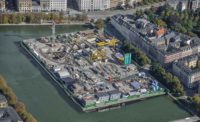The firm took on several large courthouse jobs. They include the recently completed $343-million Long Beach courthouse, the $272-million San Bernardino courthouse—slated to finish next year—and the 600,000-sq-ft federal courthouse in Los Angeles, which broke ground in August. The Los Angeles project, which is seeking a LEED-Platinum rating, features a 225-kW combined cooling, heating and power system.
The Long Beach courthouse, the product of a public-private partnership, gave ACCO's engineering staff the task of analyzing the proper mechanical systems based on life-cycle costs, because the developer will service and maintain the building for an annual performance-based fee for 35 years, Marrs says.
When the economy brightened, ACCO's business picked up, based on "getting back to basics and good business practices," Narbonne says. "When the economy came back, we came back at a high velocity."
ACCO's internal investment decisions also helped speed its recovery. "That has been our tradition: When faced with construction cyclicality, we've actually invested in our company," says Ken Westphal, president and COO of the firm's building services group. "Where most people were reducing overhead and reducing infrastructure, we were actually building infrastructure."
ACCO also had the financial wherewithal to avoid painful layoffs. "When other contractors were cutting back, we had the opportunity to pick up some highly skilled people that were portable; that gave us an opportunity," Westphal says. "Skilled people knocked on our door, and we made room."
In 2010, the company initiated an employee stock ownership plan in which most workers have participated. "It's made us more productive," Marrs says. "You've got everybody engaged at a different level." It also is another draw to attract new talent, he adds.
ACCO's high staff-retention rate has led to repeat business from general contractors such as Hathaway Dinwiddie, which has used the firm for about 30% of its building projects in Southern California since 1985, says Steve Smith, senior vice president in Hathaway Dinwiddie's Los Angeles office.
For example, on the recently completed 450,000-sq-ft Cedars-Sinai Advanced Health Sciences Pavilion, ACCO installed 1.1 million lb of sheet metal for Hathaway Dinwiddie, including 200,000 lb of complex roof duct, with sections as large as 264 in. by 78 in. Smith says ACCO has a "large capacity for ... major projects and the resources to bring to bear on almost any type of mechanical system."
Prefabrication and jobsite technology, such as the Trimble system, have enabled ACCO to boost productivity on complicated jobs like Cedars-Sinai. Starting with the BIM model, ACCO developed a sectioning plan for piping and ductwork and sent the details to its fabrication shop for assembly. Sections up to 20 ft were brought to the jobsite and installed immediately, making the whole operation efficient, says Ron Falasca, ACCO senior vice president and project executive.
The congested Levi's Stadium site and complex sequencing of the various trades required multiple daily deliveries of prefabricated sections as heavy as 20,000 lb and up to 30 ft long. "The limited site lay-down space and speed of construction required that we take our just-in-time delivery of pre-assembled duct and pipe to new levels," says Leonard Bertolami, ACCO senior vice president.










Post a comment to this article
Report Abusive Comment